‘Too much time to get to the gym…’,’Gym subscription costs too much…’, ‘I am afraid to go to the gym during pandemic’. No matter the reason, you should know that your body is a sufficient equipment itself to perform a good training and stay in shape! Of course, as Mariusz Pudzianowski says: ‘Nothing will be done by itself’. However, I will give you a list of exercises that you can perform at home or anywhere you want, together with a sample workout structure. The only thing you need is a bit of self-motivation. Let’s go!
Note 1: If there are 2 photos, the first represents the starting position, the second represents the exercise in the end phase of the motion, and then you should come back to the starting position again – this sequence is 1 repetition.
Note 2: Being at home I highly recommend working out barefoot. You get better contact with the floor and therefore better stability. Additionally, you work on the functionality of your feet.
Core
Since it’s responsible for stabilization and therefore for proper technique of almost all the exercises, it’s important to always activate the core while working out.
1. Side plank
(Intermediate)
Tips: Keep the body in a straight line; lift your hips in the air and come back to the starting position (it equals 1 rep).
Lower body
1. Squats
a) Air squat (easy) – Even though in bodyweight version is not too demanding, the conventional squat is still a very functional exercise that everyone should do. To make it harder, extend the time under tension, experimenting with the time of concentric and eccentric phase (e.g. 5:1:1, which means 5 sec descending, 1sec ascending, 1 sec pause). To brace the core correctly, take a breath using the diaphragm (360 breathing method).
Tips: Keep your core and glutes engaged; try to keep the chest in the most upright position as possible; push the knees out; feet positioned out up to 30 degrees.
b) Single leg sofa squat (intermediate) – great variant instead of usual squats, your quads will burn if you do enough reps. If keeping the second leg elevated is too hard, start with sliding it on the ground.
Tips: Keep your core tight (don’t arch the lower back); keep the glute engaged (don’t let the load go through the knee).
5. Hip thrusts /Glute bridges
Probably the best 2 bodyweight exercises that focus solely on glutes strengthening. And glutes are very important element in the correct technique of many exercises. Also, if you have a sedentary lifestyle, these 2 exercises are definitely for you. Both exercises can be performed bi and unilaterally.
a) Bilateral (easy) – glute bridges on the photos below
Tips: Engage abs = don’t arch lower back; push with the knees out during the concentric phase; hold at the top of the motion for 2-5sec.
b) Unilateral (hard)– hip thrusts on the photos below – great variation to identify muscle imbalances. If you feel more your quads and hams over the glute, it means that your glute is dormant and requires activation.
Tips: Same as for the glute bridges; + drag your chin close to the chest while going up.
7. Calf raise
(Easy)
Put some shoes for this exercise. Find yourself an elevation that will let you get full range of motion. If it’s too hard on 1 leg, start with bilateral version.
Tips: Try to do the concentric phase dynamically and then slowly descend, keeping the tension through the eccentric motion.
9. Copenhagen Adductions
(Hard)
To perform it, you’ll need a chair and something soft to place your leg on. If the straight leg version is too challenging, start with the bent knee. This exercise will strengthen your adductors and therefore help with overall knee stability.
Tips: Keep the body in a straight line (don’t arch your lower back).
10. Abductor leg raises
(Easy)
This exercise helps to strengthen gluteus medius and minimus, the two often neglected muscles, which also play an important role in the knee stability.
Tips: Keep the body in a straight line; rotate your leg internally and aim with the heel to the ceiling – this will help you activate the right muscles.
Upper body
1. Push-ups
One of the best bodyweight exercises that primarily targets the pectoralis muscles, but due to the need of stability we need to engage almost all the body to perform it correctly.
c) Legs elevated (hard) – in this version hands stay on the ground, and legs on the elevation – exactly opposite to the first version with upper body elevated (to increase the load, put a backpack filled with some weight)
Tips: Hands neutrally (don’t twist the wrist in or out); Depress your shoulder blades; keep elbows maximum 45° from the body; keep the core tight (don’t let the lower back to arch).
2. Pull-ups
3. Pike push-ups
(Intermediate)
Depending on the level of advancement, the progression in this exercise should be the same as in the normal push-ups. Elevated upper body -> Standard (the photo) -> Legs elevated.
Tips: Keep the back straight; fingers pointed forward; elbows around 45-60° from the body.
Sample plans
Before every workout session, remember to do a warm-up. 5-10min of dynamic stretching will be sufficient before a bodyweight training. All the unilateral exercises should be performed given number of reps per each side. For the sake of length of the article, I haven’t included abs exercises (not considering the 2 core exercises). Perhaps in the future I will dedicate a separate post to this topic. 🙂
In a bodyweight workout I highly recommend doing a circuit – 1 set of each exercise equals 1 circuit. Using different muscle groups after each other, you can do shorter breaks between each set and therefore save more time. Additionally, such a workout will also positively affect your cardiovascular fitness.
Of course, these are only sample plans, so you need to adjust them to your own capabilities. Always prioritize the technique over the volume in training. Depending also on the time you want to dedicate to the workout, play around with number of sets and reps, make it more or less challenging, and make it also enjoyable. Just bear in mind that all the muscles play a role in your body. So don’t neglect any of them (e.g. don’t play a cool bro from the gym, pumping only chest and biceps), but take more holistic and healthy approach. 😉
*amrap – as many reps as possible
Plan A
- Bird dogs 3×10-15 reps
- Leg lateral raises 3×10-15 reps
- Squats 3x 15-30 reps
- Hamstring slides 3×8-12 reps
- Push-ups (choose yourself a variation) 3x amrap
- Table pull-ups 3x amrap
- Pike push-ups 3x 5-15reps
- Biceps table curls 3x amrap
+ Optionally 1 exercise for abs at the end.
Plan B
- Side plank 3×8-15 reps
- Copenhagen adductions 3×8-10 reps
- Step-ups 3x 10-15 reps
- Unilateral deadlift 3×10-15 reps
- Hindu/Regular Push-ups 3x amrap
- Door/Floor sliding pull-ups 3x amrap
- Prone Y raises 3x 8-12reps
- Triceps push-ups 3x amrap
+ Optionally 1 exercise for abs at the end.
Conclusions
No matter the place and time, you can always stay active! Lack of equipment, time or even money is not an excuse. Start to work on your health and shape here and now, wherever you are. If something stops you, it is probably only that lazy part of you. I hope this article will inspire you to be active also at home. See you in the next one! 💪
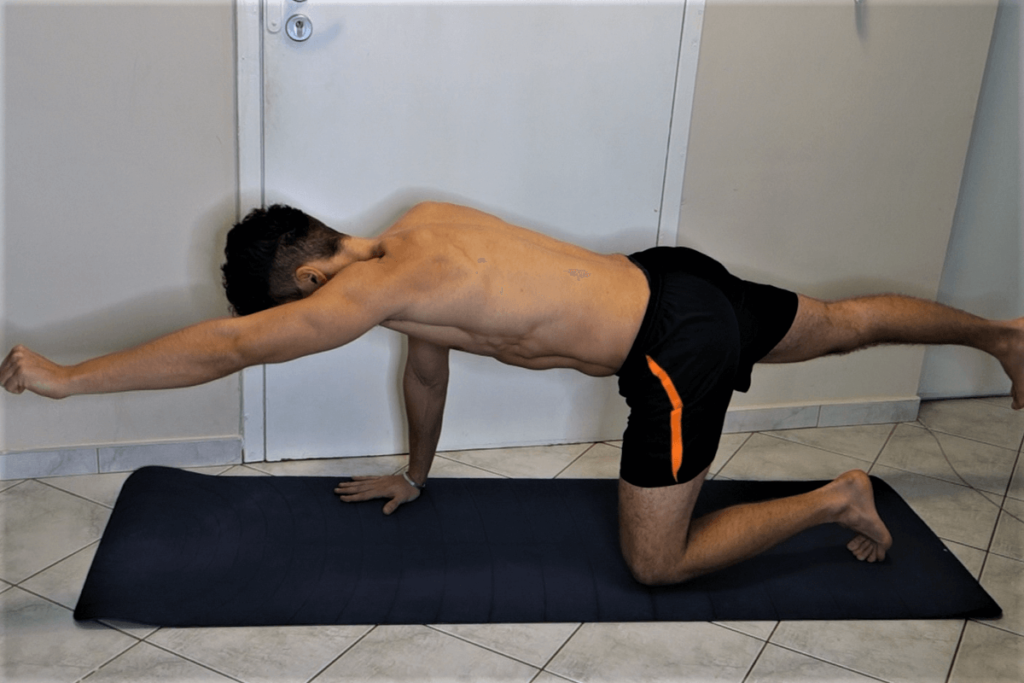







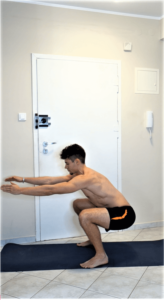















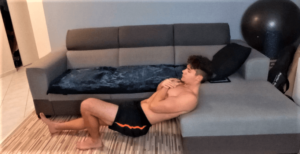


















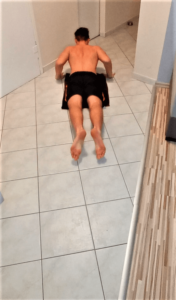








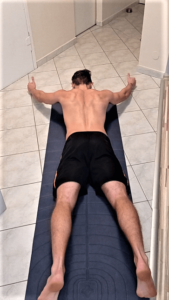

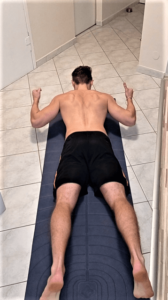





This is awesome! I am referring to this article over and over again. I don’t have the possibility to always go to gym, and I didn’t know you can replicate so many exercises with different degrees of difficulties without any equipment. This was super helpful! Dzieki Emil!
Thanks! And have a great workout 😁💪
Pingback: How to warm up before a workout - PUMPING HEALTH
Pingback: How to build a bulletproof core (10 exercises) - PUMPING HEALTH